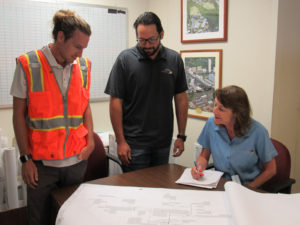The article below appeared in the June issue of Building Management Magazine.
In an industry as popular as the solar industry, there are multiple contractors. How do you choose the one who is right for you? Experience in the commercial-industrial space is significantly different than that of residential contractors and should be the first thing you look for in your evaluation process. The design, engineering and interconnection options are more intricate for commercial buildings. Further complicating the process is that each island has its own rules. You want to look for a contractor who has operated on multiple Hawaii islands.
A key area of differentiation for commercial contractors is safety protocol, which is considerably more rigorous for commercial-industrial buildings than it is for homeowners.
Hawaii Occupational Safety and Health Administration (HiOSH) is one of 26 jurisdictions approved by the Federal Occupational Safety and Health Administration (OSHA) to operate its own state’s safety and health program.
Another area of distinction is the overall makeup of commercial-industrial buildings: roofs are higher; there are public areas and larger number of occupants in the building and in the surrounding area.
Installing solar on a building in heavily trafficked commercial spaces is an entirely different process than on a single-family residential dwelling. Look for a contractor who has a variety of commercial experience from shopping centers to warehouses. These contractors understand the scope and idiosyncrasies of industrial projects and have developed a sixth sense about issues and how to work out solutions.
The nitty gritty, however, is in the analysis of the available interconnection programs. Residential contractors deal with limited interconnection programs whereas commercial contractors must analyze multiple options.
An experienced commercial solar contractor should be able to give you a track record of analyses they have performed for other customers. Ask for references and a list of clients. There are a number of different approaches, including a storage component, available and a top-notch contractor should provide a variety of interconnection options, including the permits needed and the approximate time needed to get them.
Also place value on a contractor who can maximize the productivity and longevity of the solar installation with its operations and maintenance program. Preventive maintenance in Hawaii with its proclivity for rust is key. A good O&M program looks for the early signs of corrosion and rust and makes repairs before a problem develops and also notes which areas are more likely to develop issues in the future. Regular inspections and maintenance are imperative for a successfully operating system. If something does go wrong, you want a contractor who’ll immediately roll out a truck and make repairs. Downtown is not your friend.
Yes, there are multiple commercial solar contractors and several who can fill the bill for all or some of the recommended specifications above. Make the tipping point in your selection trust.
Trust that your contractor will be available to you in the years to come. Trust that they are involved in the Hawaii community and value their reputation. Trust that they will continue to be your partner and provide the best possible advice and service.
Hawaii Occupational Safety and Health Administration (HiOSH) is one of 26 jurisdictions approved by the Federal Occupational Safety and Health Administration (OSHA) to operate its own state’s safety and health program.
Another area of distinction is the overall makeup of commercial-industrial buildings: roofs are higher; there are public areas and larger number of occupants in the building and in the surrounding area.
Installing solar on a building in heavily trafficked commercial spaces is an entirely different process than on a single-family residential dwelling. Look for a contractor who has a variety of commercial experience from shopping centers to warehouses. These contractors understand the scope and idiosyncrasies of industrial projects and have developed a sixth sense about issues and how to work out solutions.
The nitty gritty, however, is in the analysis of the available interconnection programs. Residential contractors deal with limited interconnection programs whereas commercial contractors must analyze multiple options.
An experienced commercial solar contractor should be able to give you a track record of analyses they have performed for other customers. Ask for references and a list of clients. There are a number of different approaches, including a storage component, available and a top-notch contractor should provide a variety of interconnection options, including the permits needed and the approximate time needed to get them.
Also place value on a contractor who can maximize the productivity and longevity of the solar installation with its operations and maintenance program. Preventive maintenance in Hawaii with its proclivity for rust is key. A good O&M program looks for the early signs of corrosion and rust and makes repairs before a problem develops and also notes which areas are more likely to develop issues in the future. Regular inspections and maintenance are imperative for a successfully operating system. If something does go wrong, you want a contractor who’ll immediately roll out a truck and make repairs. Downtown is not your friend.
Yes, there are multiple commercial solar contractors and several who can fill the bill for all or some of the recommended specifications above. Make the tipping point in your selection trust.
Trust that your contractor will be available to you in the years to come. Trust that they are involved in the Hawaii community and value their reputation. Trust that they will continue to be your partner and provide the best possible advice and service.


